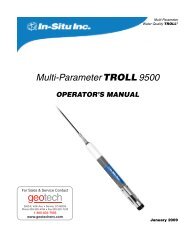TEST INSTRUCTIONS - Geotech Environmental Equipment
TEST INSTRUCTIONS - Geotech Environmental Equipment
TEST INSTRUCTIONS - Geotech Environmental Equipment
Create successful ePaper yourself
Turn your PDF publications into a flip-book with our unique Google optimized e-Paper software.
SULFIDE–LOW RANGE<br />
METHYLENE BLUE METHOD CODE 3654-01-SC<br />
QUANTITY CONTENTS CODE<br />
2 x 30 *Sulfide Reagent A *V-4458-G<br />
15 mL *Sulfide Reagent B *V-4459-E<br />
2 x 60 mL Sulfide Reagent C 4460-H<br />
2 Pipets, 1.0 mL, plastic 0354<br />
*WARNING: Reagents marked with an * are considered hazardous substances. To<br />
view or print a Material Safety Data Sheet (MSDS) for these reagents see MSDS CD<br />
or our web site. To obtain a printed copy, contact us by e-mail, phone or fax.<br />
Sulfide occurs in many well water supplies and sometimes is formed in lakes or<br />
surface waters. In distribution systems, it may be formed as a result of bacterial<br />
action on organic matter under anaerobic conditions. It may also be found in<br />
waters receiving sewage or industrial wastes. Lake muds rich in sulfates produce<br />
hydrogen sulfide during periods of very low oxygen levels that result from<br />
stagnation. Concentrations of a few hundredths of a part per million (or<br />
milligram per liter) cause a noticeable odor. At low concentrations, this odor is<br />
described as “musty”; at high concentration, as “rotten eggs.” Removal of<br />
sulfide odor is accomplished by aeration or chlorination. Hydrogen sulfide, a<br />
toxic substance, acts as a respiratory depressant in both humans and fish.<br />
APPLICATION: Drinking, surface and saline waters; domestic and industrial<br />
wastes.<br />
RANGE: 0.00–1.50 ppm Sulfide<br />
METHOD: Under suitable conditions the sulfide ion reacts with<br />
p-aminodimethylaniline and ferric chloride to produce<br />
methylene blue in proportion to the sulfide concentration.<br />
Ammonium phosphate is added to remove the color due to<br />
SAMPLE<br />
HANDLING &<br />
PRESERVATION:<br />
the ferric iron.<br />
Samples must be taken with a minimum of aeration since<br />
sulfide is volatilized by aeration and any oxygen which is<br />
taken up will destroy sulfides by chemical action. Samples<br />
that are used for total sulfide concentrations may be<br />
preserved by adding 2M zinc acetate solution at a dosage of 2<br />
mL per liter of sample. This precipitates sulfide as inert zinc<br />
sulfide. Determination of dissolved sulfides in samples not<br />
preserved with zinc acetate must be started within 3 minutes<br />
of sampling.<br />
INTERFERENCES: Strong reducing agents such as sulfite, thiosulfate, and<br />
hydrosulfite prevent the formation of the color or diminish<br />
its intensity. High concentrations of sulfide will inhibit the<br />
reaction, but dilution of the sample prior to analysis<br />
eliminates this problem.<br />
Smart2 <strong>TEST</strong> PROCEDURES 2.04 Sulfide–LR 1/2

















